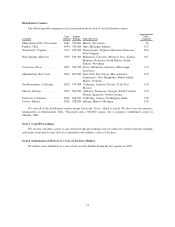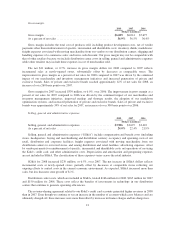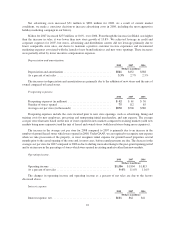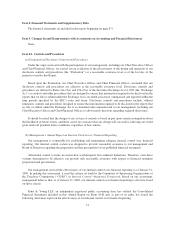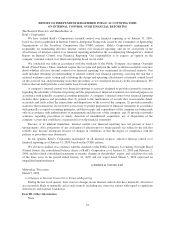Kohl's 2008 Annual Report Download - page 24
Download and view the complete annual report
Please find page 24 of the 2008 Kohl's annual report below. You can navigate through the pages in the report by either clicking on the pages listed below, or by using the keyword search tool below to find specific information within the annual report.Operating activities.
Despite the decrease in net income, cash provided by operations increased 38% over 2007 to $1.7 billion in
2008. This increase in operating cash flow was primarily attributable to a $335 million reduction in cash used for
inventory purchases.
At January 31, 2009, total merchandise inventories decreased $57 million, or 2%, from year-end 2007. On a
per store basis, merchandise inventories at January 31, 2009 decreased 9.3% from year-end 2007. Clearance
inventory units per store are down approximately four times as much as merchandise inventories per store. These
reductions are the result of our conservative sales and receipt planning.
Accounts payable at January 31, 2009 increased $45 million from year-end 2007. Accounts payable as a
percent of inventory was 31.5% at January 31, 2009, compared to 29.3% at year-end 2007, primarily due to
strong inventory management, our cycle time reduction initiatives and improved vendor financing management.
The $1.9 billion decrease in net cash provided by operating activities for 2007 compared to 2006 was
primarily due to the cash proceeds of $1.6 billion received in April 2006 in conjunction with the sale of our
proprietary credit card portfolio. The primary use of operating cash flow for 2007 was an increase in merchandise
inventories of $275 million. The primary source of operating cash flow for 2007 was a $149 million increase in
accrued and other long-term liabilities. Accounts payable was a $98 million use of operating cash flow in 2007,
compared to a $104 million source of operating cash flow in 2006.
Merchandise inventories used net cash of $275 million in 2007. The 11% increase in our ending inventory
balance from year-end 2006 to 2007 was primarily due to the increase in the number of stores. On a per store
basis, merchandise inventories at year-end 2007 decreased 2.6% from year-end 2006, due to conservative receipt
plans for Spring 2008.
Accounts payable at year-end 2007 decreased $98 million from year-end 2006. Accounts payable as a
percent of inventory was 29.3% at year-end 2007, compared to 36.2% at year-end 2006, reflecting reduced
receipts of Spring 2008 merchandise as a result of conservative sales planning and increased vendor allowances.
Investing activities.
Net cash used in investing activities was $1.4 billion in 2008, compared to $1.6 billion in 2007 as decreases
in capital expenditures were substantially offset by a comparable decrease in net investment activity.
Net purchases and sales of investments used cash of $439 million in 2008 and $52 million in 2007. As of
January 31, 2009, we had investments in auction rate securities (“ARS”) with a par value of $407 million and an
estimated fair value of $332 million. ARS are long-term debt instruments with interest rates reset through
periodic short term auctions, which are typically held every 35 days. Beginning in February 2008, liquidity issues
in the global credit markets resulted in the failure of auctions for substantially all of our ARS. A “failed” auction
occurs when the amount of securities submitted for sale in the auction exceeds the amount of purchase bids. As a
result, holders are unable to liquidate their investment through the auction. A failed auction is not a default of the
debt instrument, but does set a new interest rate in accordance with the terms of the debt instrument. A failed
auction limits liquidity for holders until there is a successful auction, another market for ARS develops or the
debt matures. ARS are generally callable by the issuer at any time. Scheduled auctions continue to be held until
the ARS matures or is called. Proceeds from the sale of ARS were $93 million in 2008, including $17 million
which were called at par subsequent to February 2008.
To date, we have collected all interest payable on outstanding ARS when due and expect to continue to do
so in the future. At this time, we have no reason to believe that any of the underlying issuers of our ARS or their
insurers are presently at risk. While the auction failures limit our ability to liquidate these investments, we
believe that the ARS failures will have no significant impact on our ability to fund ongoing operations and
growth initiatives.
24


